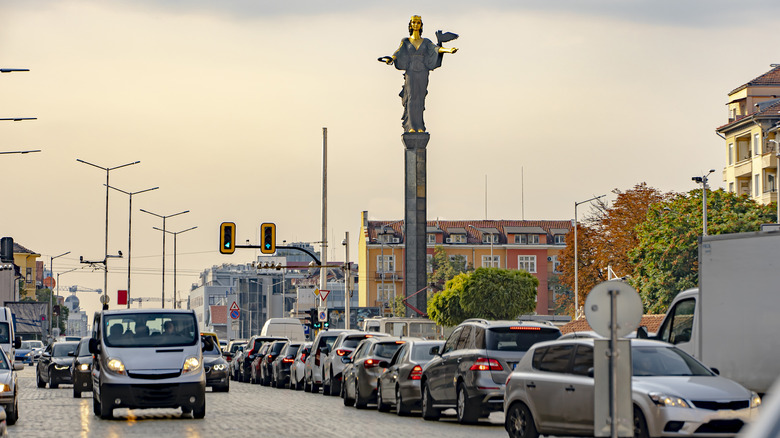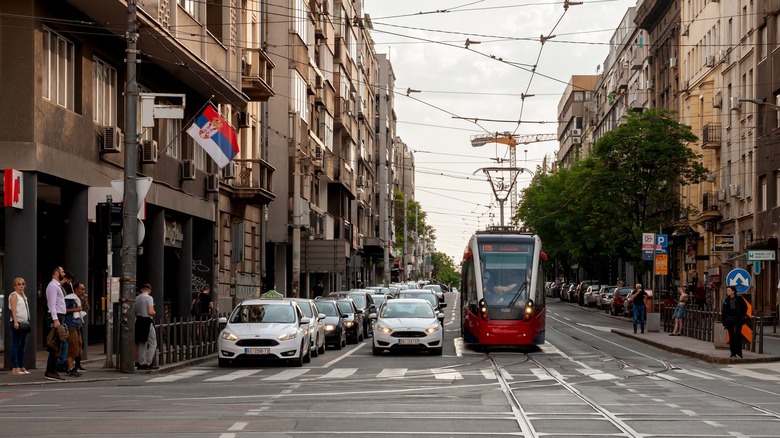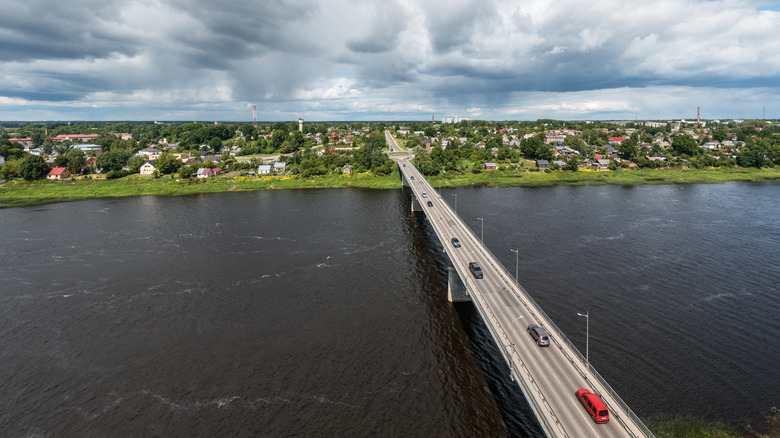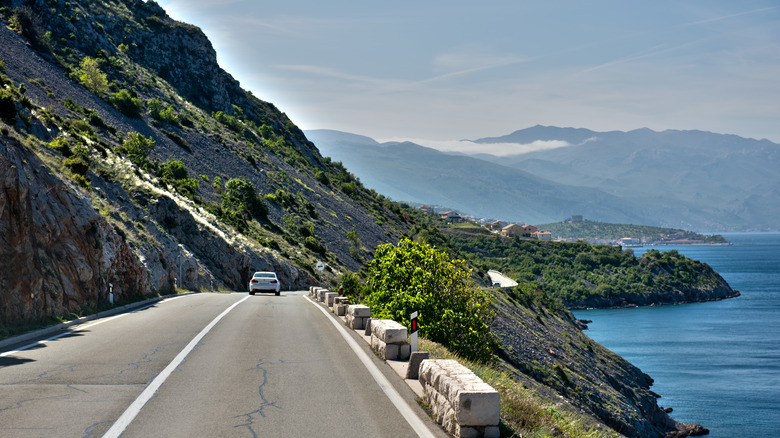These Countries Are Considered The Most Dangerous In Europe For A Road Trip
Europe may be covered in railway tracks and flight paths, but some trips around the continent call for driving. Maybe you want to country-hop throughout Europe and need a car for the most direct route. Or perhaps you plan to visit off-the-beaten-path nature spots not accessible by public transport. And, of course, a road trip is a must if you're traveling with a lot of luggage.
However, driving isn't always the safest choice, especially if you're traveling through a country with a high rate of road accidents. The website Vignetteswitzerland.com published its list of the most dangerous European countries to drive in for 2024, based on data from the European Transport Safety Council (ETSC). To determine which spots had the riskiest roads, the researchers compared the number of traffic deaths to the country's population. While the study doesn't consider specific factors that affect foreign tourists — such as which side of the road to drive on or higher-than-average speed limits — it offers insight into which countries have the most fatal accidents. Spoiler: You may want to be extra cautious when cruising around in Central and Eastern Europe.
Bulgaria is the most dangerous European country for drivers
Bulgaria is home to one of the oldest cities in the world and countless historical sites. While there's much to see in the country, you should think twice before exploring it all by car. Vignetteswitzerland.com's research found that Bulgaria is the worst nation in all of Europe when it comes to traffic fatalities. In 2023, there were 526 road deaths in the country, which may sound like a small number. But factor in Bulgaria's population of less than 6.5 million people, and the fatality rate comes out to 81.6 per million people — 79% higher than the EU's average of 45.5 deaths per million.
There are multiple factors that may explain why Bulgaria struggles with such a high traffic death toll. For one, the roads themselves may be more dangerous than those found in many other European countries. The Trakia Highway, for example, is a popular roadway in Bulgaria, yet it's dotted with potholes and in need of repair. According to a European Commission report, perceived road quality in the country is also among the lowest in the EU.
In some cases, though, driver behavior may be an influence in Bulgaria's road deaths. Locals are stereotyped as being aggressive behind the wheel, sometimes resulting in road rage incidents. Another issue is substance use. A survey by Trend (via Novinite.com) revealed that one in five Bulgarians has been in a car with an intoxicated driver, and 37% have watched someone they know drive after using drugs or alcohol. Notably, the Balkan country has some of the highest speed limits in the EU, which, when combined with risky driving behaviors, can be a deadly combination.
Be careful driving in Romania
Similar to Bulgaria, Romania has a high rate of road fatalities, especially when compared to the EU average. Bulgaria's neighbor to the north suffered 1,545 road deaths in 2023, or 81.1 per million inhabitants. This comes out to be 78% above the average for Europe.
Some of the same issues seen in Bulgaria also plague Romania. The European Commission found that Romania has the worst perceived road quality in the continent, with rural roads often having poor lighting and narrow lanes. Some secondary routes also lack paving and markings, making them especially dangerous to navigate. That said, the majority of Romania's traffic fatalities occur on urban roads, and an above-average share — 39% — involve pedestrians, not vehicle occupants. Take this as a sign to remain alert near Romanian roads if you visit, even if you aren't behind the wheel.
Also, take note of the Balkan country's reckless drivers. Some locals drive aggressively, and the defensive driving norms you may be used to might not be followed by everyone on Romanian roads. However, one plus is that the country has a zero-tolerance approach to driving under the influence, and any driver found to have a blood alcohol level exceeding 0.0 can be punished.
Serbia placed third on the list of dangerous countries for drivers
Serbia, a country that shares a border with Bulgaria and Romania, is also among the most dangerous countries in Europe for a road trip. There, you'll find the underrated wine destination of Belgrade, beautiful national parks, and one-of-a-kind architecture. But between these destinations, look out for risks on the road.
In 2023, Serbia recorded 503 traffic-related deaths, which, for its population of 6,641,197, comes out to 75.7 per million people. That's 66% above the average for the EU. While the likelihood of getting into an accident is still high, the Vignetteswitzerland.com report noted that Serbia has reduced its road fatalities by 23% since 2013.
According to a 2019 research article published in the International Journal of Injury Control and Safety Promotion, speeding, dangerous overtaking and passing, and "the physical condition of the driver" are the most common factors in traffic accidents in Serbia. On some roads, it's especially important to remain alert and in control of your vehicle. Ibarska Magistrala, sometimes referred to as "Ibar Highway" or the "Black Highway," is considered one of the most dangerous roads in Europe. The busy highway connects the country's major cities and is known for its hazardous curves and equally hazardous drivers.
Latvian roads are some of the most dangerous in Europe
If your road trip takes you to the Baltics, be cautious when driving in Latvia. The Northeastern European country sees its fair share of traffic fatalities, according to Vignetteswitzerland.com. Latvia is just behind Serbia, with 75.4 road deaths per million inhabitants, totaling 142 deaths in 2023.
The reasons for these fatalities aren't so different from other high-risk countries in the EU. Anna Kononova of Latvian State Roads told Euronews, "According to data in European countries, three main reasons for car accidents are speeding, consuming alcohol before driving and not using safety belts. In Latvia, it is also the pedestrians factor." Pedestrians make up one-third of traffic death victims in Latvia, according to the European Commission, which is a significantly higher share than the average for the continent.
Poor road conditions are another risk for drivers in Latvia. Some roads are made of gravel, and even those that are paved are often in need of repair. This may at least partially explain why a large proportion of road fatalities in Latvia occur in darkness, when visibility is low and drivers may not see potholes and lane barriers.
Croatia rounds out the top five
A car will come in handy when getting around Croatia, from going on Rick Steves' recommended mountainous European road trip to exploring the country's long coastline. However, it's important to keep in mind that the Balkan country is one of the most treacherous in the EU for drivers. Croatia, with a population of nearly 4 million, recorded 274 road deaths in 2023, a rate that's 56% higher than the EU average when compared to other European countries. The good news, however, is that Croatia's per capita road fatalities have fallen by 26% since 2013.
Croatian roadways are generally considered to be safe and in good shape, unlike some other countries in the region. Instead of damaged streets and unmarked lanes, travelers should primarily watch out for other drivers when road-tripping in Croatia. According to a government road safety plan, an estimated 59% of serious accidents in Croatia can be linked to reckless driving. Moreover, 39% of traffic fatalities and severe injuries may have been caused by speeding, which can lead to collisions and other car accidents.





